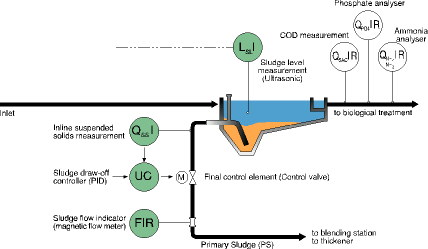

Automation in a wastewater plant is not a 'nice-to-have' anymore, but has become a necessity. The demand on water quality and output has forced water companies to look at optimising their modus operandi. It was Albert Einstein who said: "The significant problems we face cannot be resolved at the same level of thinking we were at when we created them." The purpose of this series of articles will be to address some of these problems. We will focus on areas of a wastewater plant, which are known to cause problems. The first area we will discuss is the primary settling tank or PST.
In a typical wastewater plant, large quantities of sludge must be handled. The main purpose of any wastewater process is to permit separate treatment of the solids and the liquids:
* The liquids to be treated and put back into the mainstream (rivers, etc).
* The solids to be treated (anaerobically) and then dried and used for something else (compost, fuel, etc).
This process starts in the primary settling tank (PST). The PST is a tank or basin that uses gravity to allow solids to settle at the bottom. The tank bottom is extended to allow collection of sludge in a cone (hopper) for efficient draw off. Time is of extreme importance here; the flow through the PST must be fast enough not to allow the solids to compress, and slow enough to allow a feasible amount of solids to settle. This is usually done on a 'gut feel' method by the plant operator and can be costly if not done correctly. There are always additional factors to consider, like rain, floods, seasons etc. Some plants have the advantage of a balancing tank for this purpose (to be discussed at a later stage).
Some wastewater plants use a series of timers (electronic devices that count to a preset time and then activate or brake a contact). The purpose of these timers is to stop and start pumps and valves to control this intricate process. If this control is not done properly, the following could happen:
* Decreases in the hydraulic capacity of the PST (sludge level too high).
* Primary sludge could be too thin, carrying unnecessary water to the sludge treatment stage (solid concentration not to specifications).
* Increases in the amount of polymers used in the dewatering process (too much water in sludge).
* Costly treatment of the sludge for dewatering purposes (total operating cost).
The introduction of a relatively modest amount of control engineering can affect a complete solution for this problem that will allow the plant an enormous cost saving potential.

Fully automated control
The ultrasonic sludge level transmitter (LI) measures the sludge 'blanket' and feeds the signal to the sludge draw-off controller - UC, which uses a series of mathematical functions usually performed by the PLC to maintain a steady control to a given setpoint, which in turn opens and closes the valve, with the purpose of controlling the sludge level in the PST.
Monitoring suspended solids and using this measurement to signal a valve to close as soon as the suspended solids are becoming too diluted is a great advantage. This signal may also be fed back to upstream control loops to stop/restart the process if necessary. The combination of these inline, low maintenance instruments makes control of a PST much more efficient and reduces the total operating cost of the wastewater plant.
The benefits of this implementation include:
* Ensuring that the concentration of primary sludge is not 'too thin', preventing excessive water from making its way to the sludge treatment stage.
* Increasing the hydraulic capacity of the PST.
* Increasing the gas yield in a digester.
* Decreasing heating energy used in a digester.
* Reducing the amount of polymers used in the dewatering process.
The PST is, of course but one aspect of a wastewater plant - to optimise a plant, one needs to start at the beginning. In the next article, enhanced control strategies of biological treatment processes will be discussed.
For more information contact Grant Joyce, Endress+Hauser, 011 262 8000, [email protected], www.za.endress.com
| Tel: | +27 11 262 8000 |
| Email: | [email protected] |
| www: | www.endress.com |
| Articles: | More information and articles about Endress+Hauser South Africa |

© Technews Publishing (Pty) Ltd | All Rights Reserved